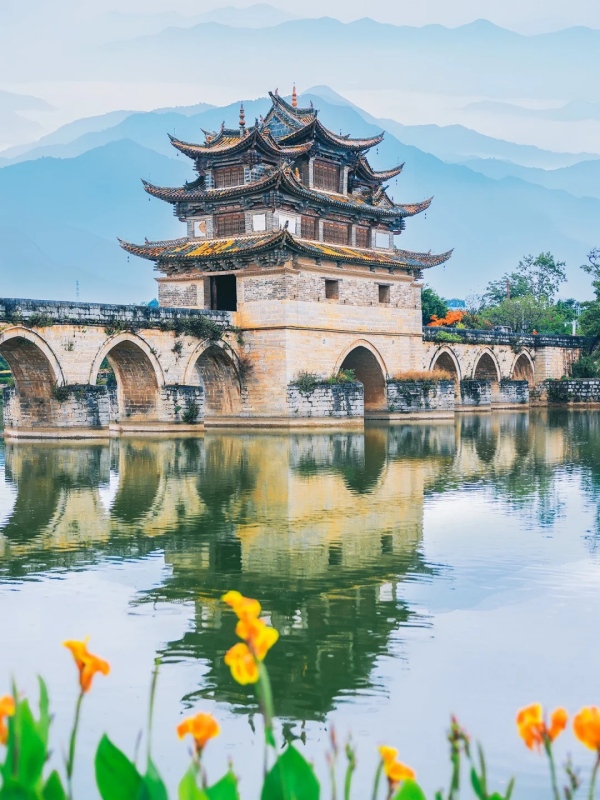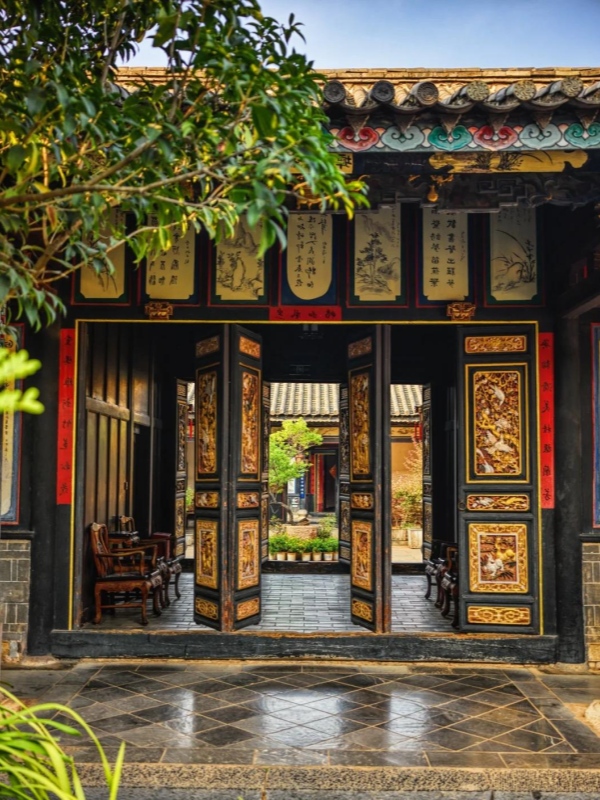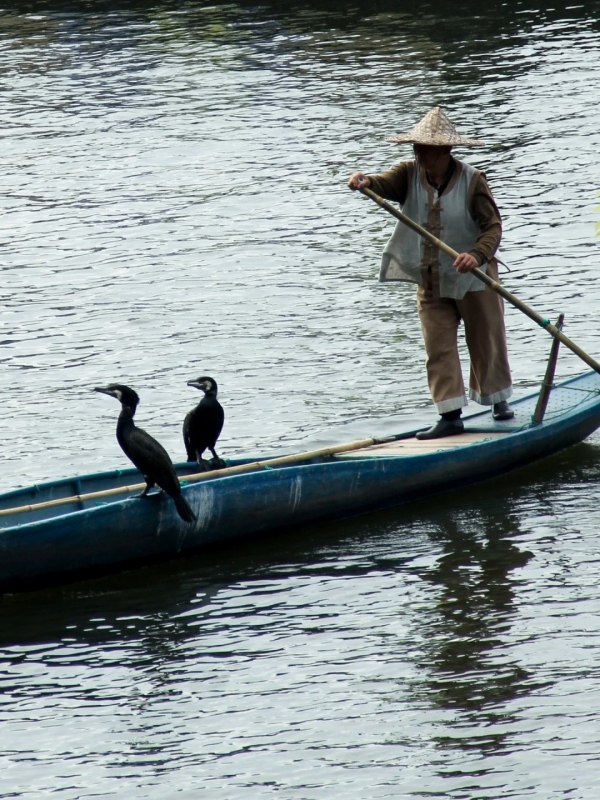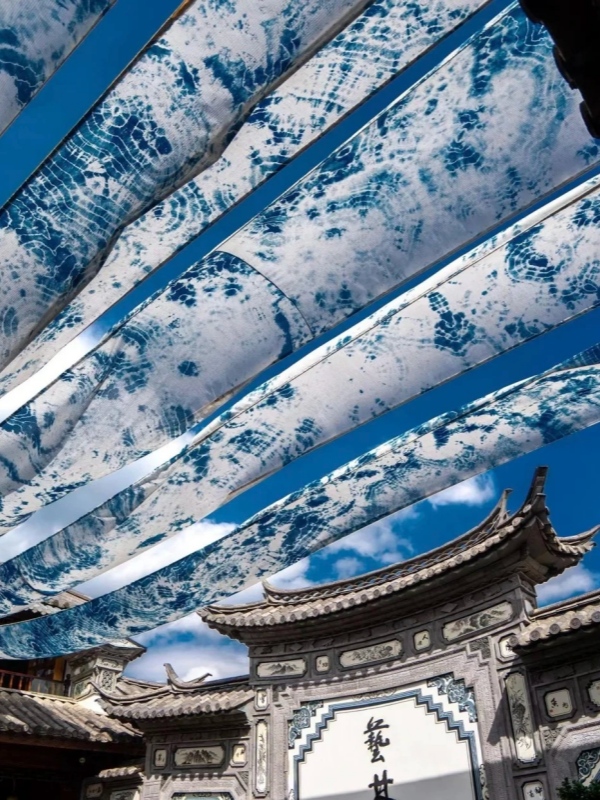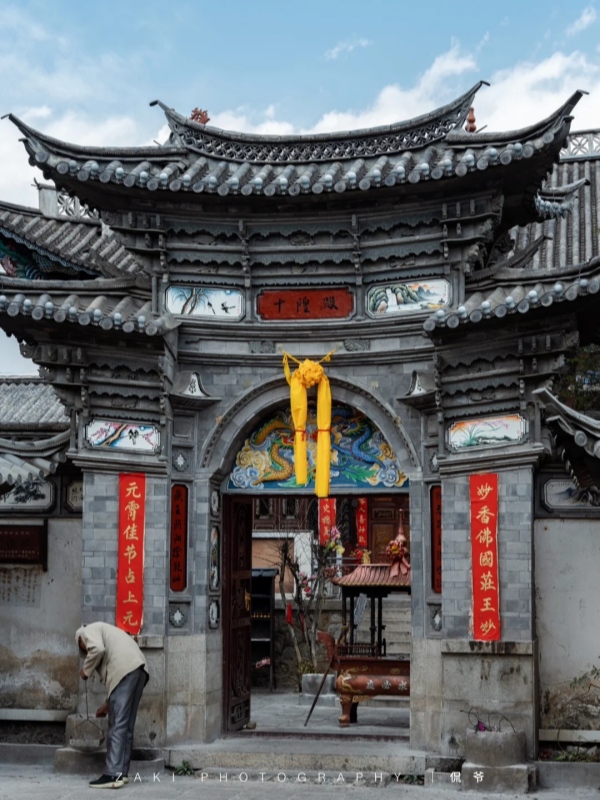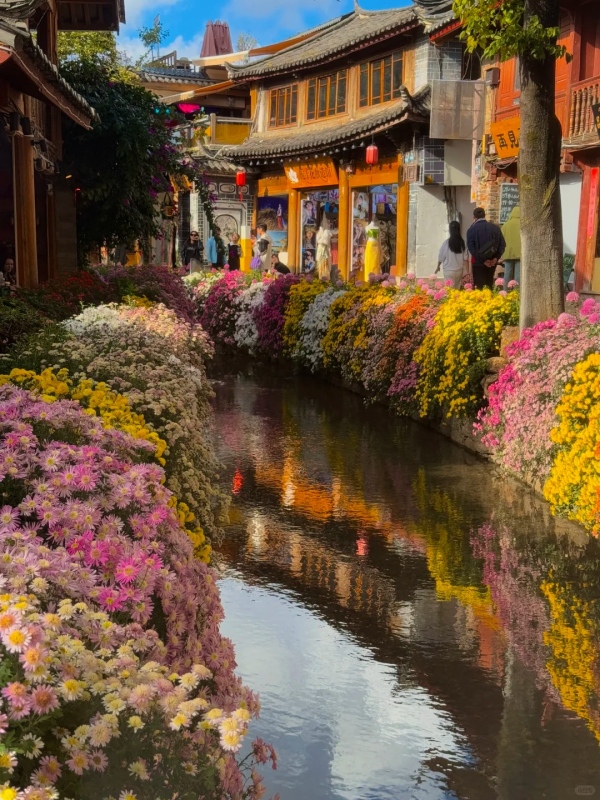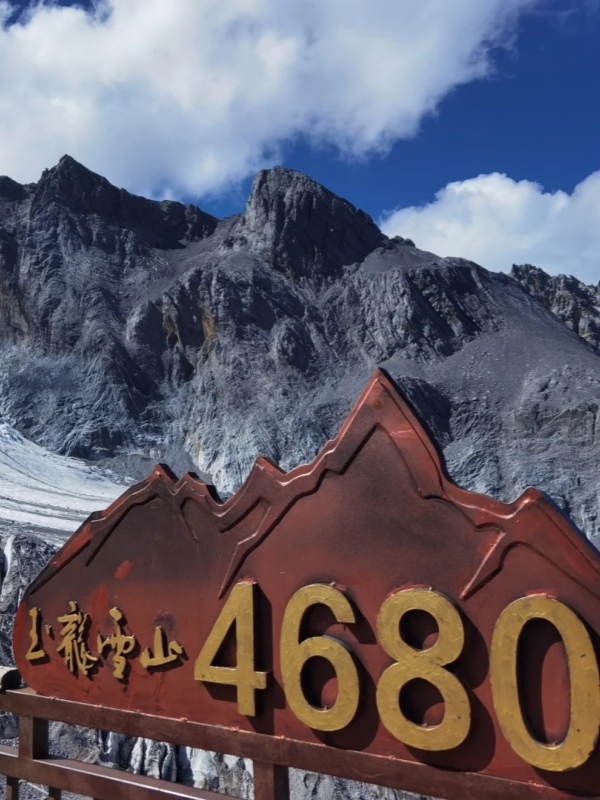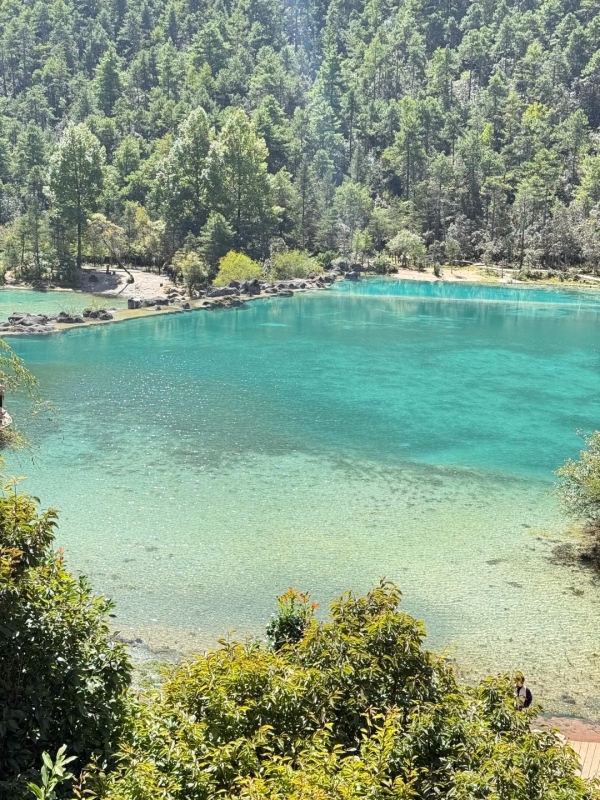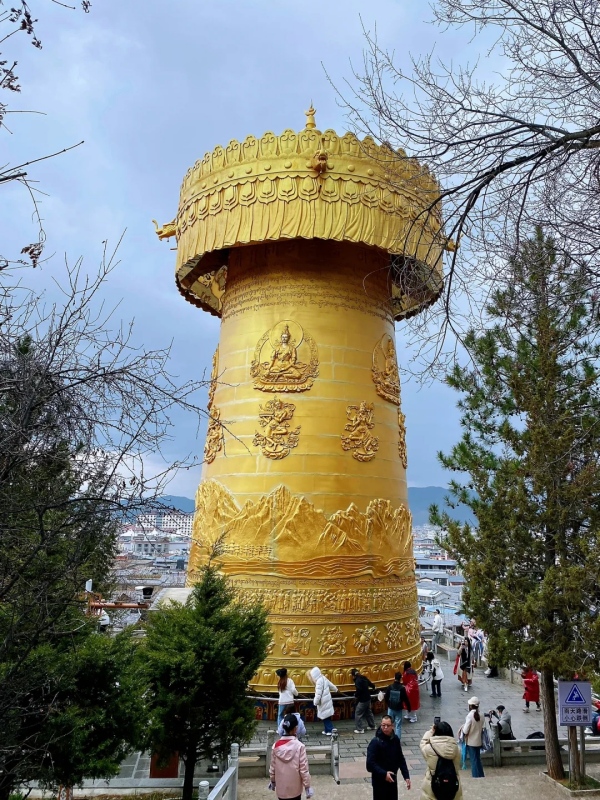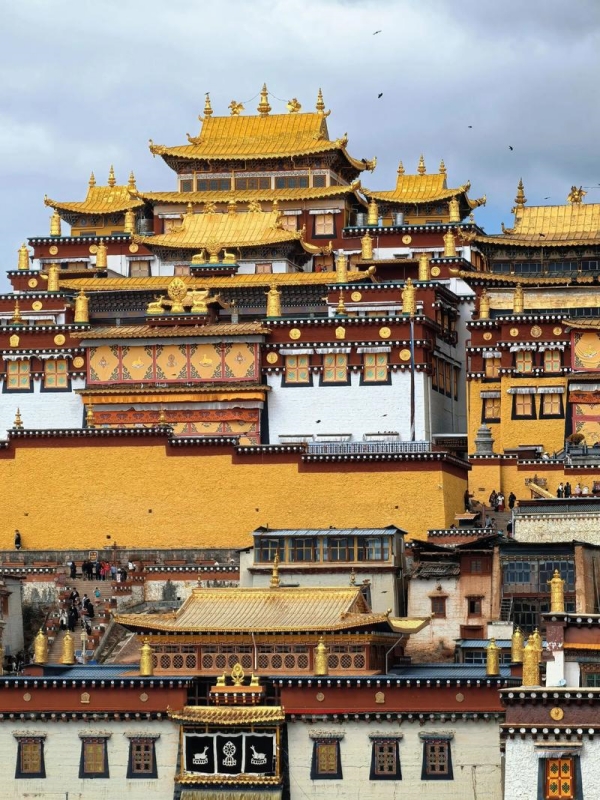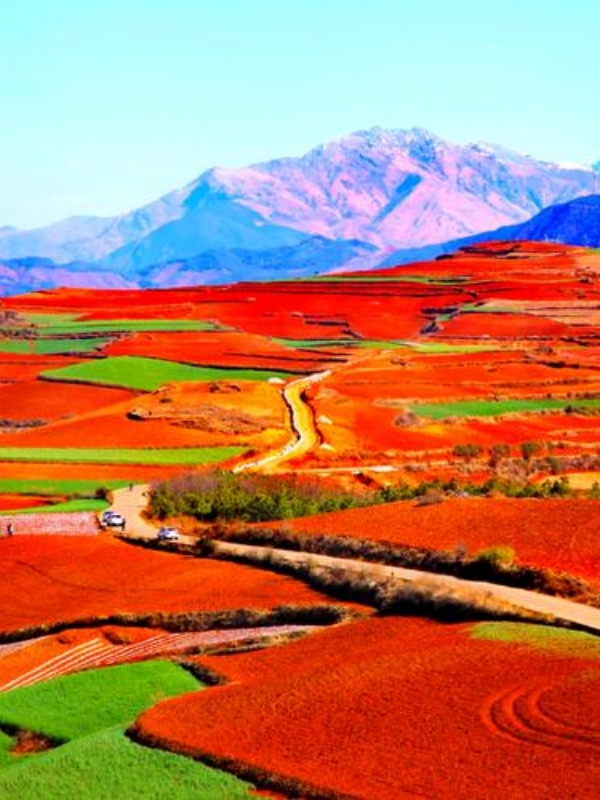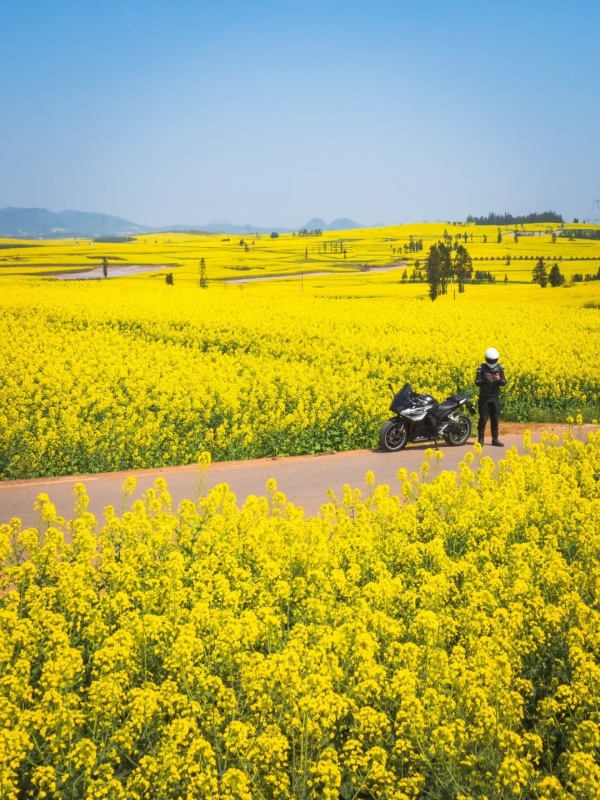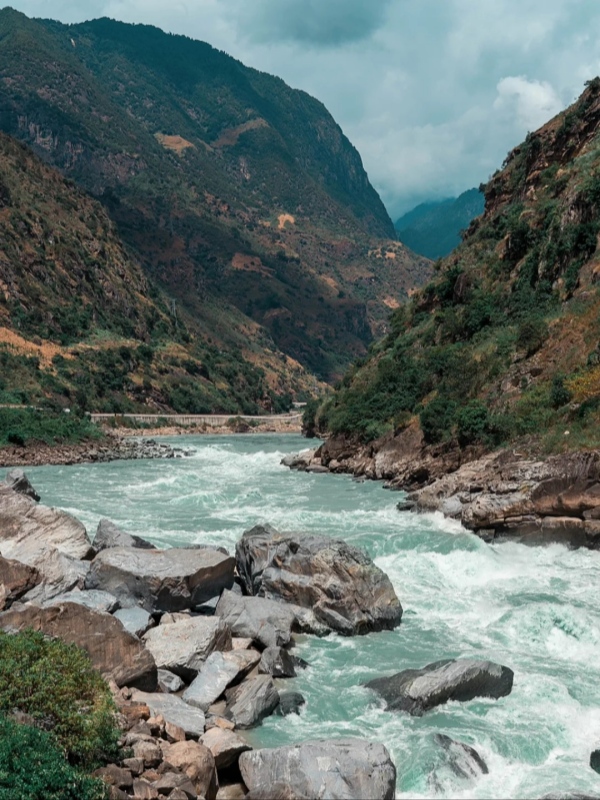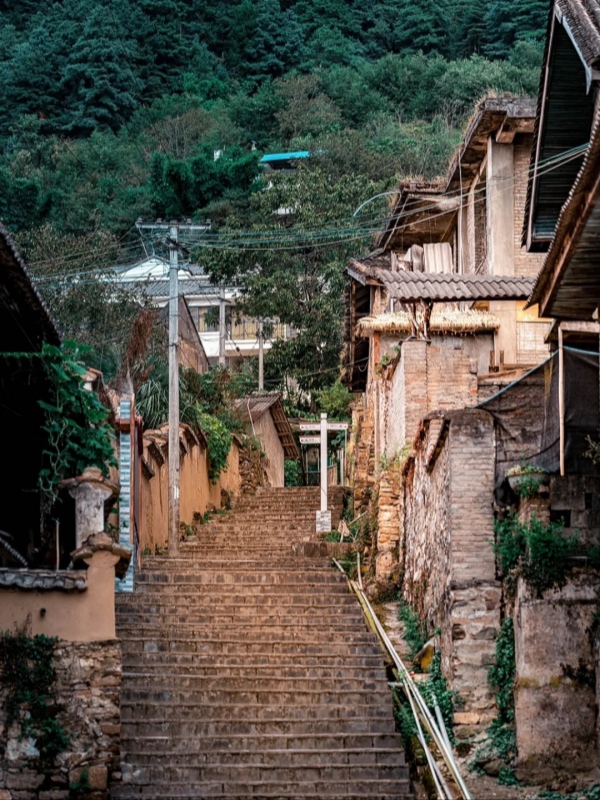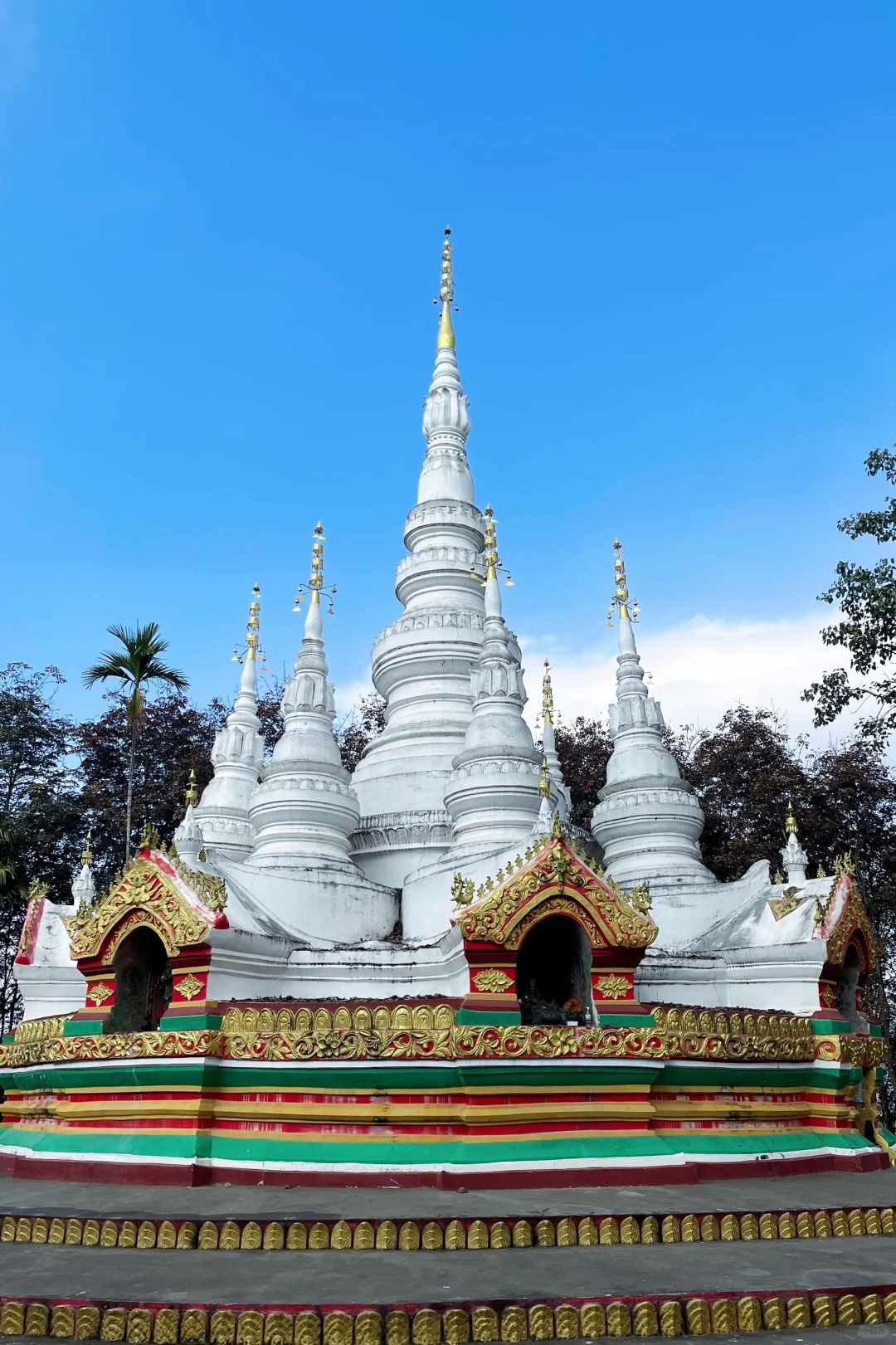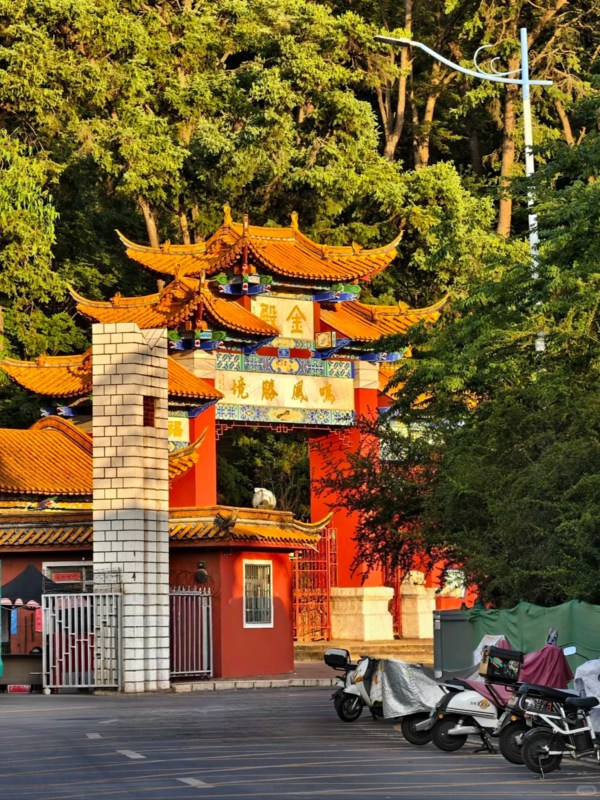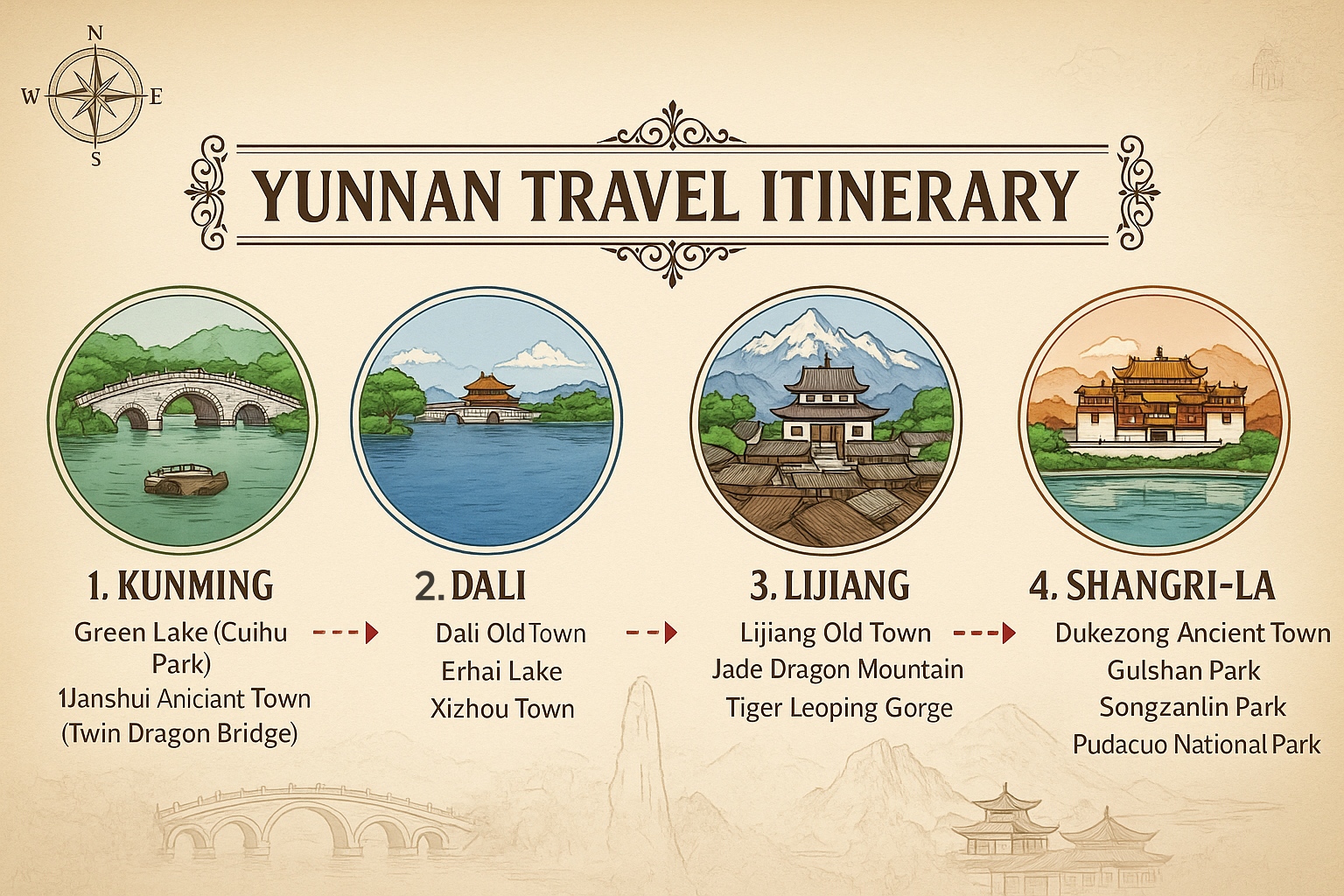
yunnan travel itinerary
A stunningly well-planned Yunnan travel itinerary is here to allow you to see all of the magic this province has to offer. I mean, let’s be serious—Yunnan is not “just a pretty place”—it is snow-capped mountains next to ancient towns, 25 ethnic groups with living traditions, and hidden gems that elude most tourists. This itinerary will take 7-10 days and is carefully constructed to reveal its fruits without random deviations or crowded stops but rather wise and pleasurable trips.
What makes this Yunnan itinerary stand out? In the fact that it is a *planned trip*, not just a list of places. We will visit Kunming, Dali, Lijiang and Shangri-La, changing out the crowded places (Stone Forest) for the authentic ones (Jianshui, village of Baisha) while keeping the must-see sights (Jade Dragon Snow Mountain, Songzanlin Monastery). As well we will include professional secrets here,—like the procurement of hard-to-get tickets, cheap places to sit on the lakes, and avoiding the rockiness of the altitude sickness. Would you like to drop the guessing and plan your perfect trip?
Days 1-2: Kunming—The Spring City Surprise
- Green Lake
- Shuanglong Bridge (Twin Dragon Bridge)
- Zhu Family Garden
Most travelers treat Kunming as a layover. That's their loss. Give this city one full day and discover why locals call it the "City of Eternal Spring." Dreaming of mild breezes and blooming streets? Visit Discover Kunming and explore a different side of the eternal spring city.
Green Lake: Where Locals Come Alive
Get to Green Lake (Cuihu Park) by 7 AM to catch the spirit of Kunming: elderly locals practicing tai chi beneath willow trees, red-billed gulls swooping in from Siberia (November to March only), and a laid-back era not found in Shanghai or Beijing.
Time needed: 2-3 hours
Pro tip: Grab jianbing (Chinese crepes) from vendors near the east gate—breakfast doesn't get more authentic than this.
Jianshui Ancient Town: Living History of Southern Yunnan
Jianshui Ancient Town presents more of the millennial cultural achievements of Yunnan. Becoming the core changeover attraction in Kunming of the programme this town, which is more than 1,200 years old, is an important relay station on the Ancient Tea Horse Road. It possesses still entire buildings of the architecture of the Ming and the Ch'ing dynasties.
The 17-arch Shuanglong Bridge (Twin Dragon Bridge) is over the coming together of the Lujiang and Tachong rivers, and the effect of structure and reflection on the water gives a complete and perfect union, and a unique sample of the ancient bridge engineer's skill. The Zhu Family Garden in the town, called the "Grand View Garden of Southern Yunnan," possesses in its exquisite carved beams and painted rafters the architectural art of the southern Yunnan dwellings.
Essential info:
- Entry: Free (individual attractions like Zhu Family Garden cost ¥40)
- Time needed: 3-4 hours for highlights
- Golden rule: Visit the morning market on Dongjie Street to taste rice noodles with 20+ toppings and watch locals make tofu pudding
- Bonus: Soak in the world's only "well-tempered" hot springs at Chen Family Compound—natural hot water regulated by ancient well systems
Where to Stay
Best neighborhood: Green Lake area (Cuihu) puts you near restaurants, metro, and actual neighborhood life. Mid-range options like Cloudland International Youth Hostel run ¥200-400/night.
Skip: Train station area—you'll save ¥50 but sacrifice evening atmosphere and walkability.
Hidden benefit: At 1,900 meters elevation, Kunming primes your body for higher altitudes ahead. If you feel winded climbing stairs, that's normal—and helpful preparation.
🍜 Must-eat: Crossing-the-bridge noodles (guoqiao mixian) at any local spot. This is Kunming's signature dish, and the touristy versions can't compete.
Days 3-5: Dali—Ancient Soul with Modern Spirit
Dali delivers what Lijiang lost years ago: an ancient town that still breathes with real life. Interested in Dali’s mix of nature and heritage? Explore Things to Do in Dali to dive into Bai customs and local stories.
- Fuxing Road
- Cormorant Fishing Techniques
- Bai Tie-dye Craftsmanship
- Xizhou
The Old Town's Hidden Rhythm
As Lijiang languishes under a plague of selfie sticks, the morning markets of Dali along Fuxing Road hum with local residents buying vegetables from the Bai Minority’s whitewashed architecture, be it photo-op-worthy, but the real beauty is in their leisurely pace.
Smart tip: Rent an electric scooter (¥50/day) and cruise down the car-free paths, avoiding the throngs of tourists. The west gate area is much quieter than the busy Renmin Road tourist strip. It is prime territory for family-run guesthouses with rooftop terraces overlooking Cangshan Mountain.
Erhai Lake: The 116-Kilometer Loop (Enhanced with Xizhou)
Cycling around Erhai Lake and visiting Xizhou Ancient Town gives visitors greater depth in experiencing the essential characteristics of Dali, namely the "concurrent mountains and water" and "profound cultural charm". Being the second largest fresh water lake in Yunnan, it has natural beauty described as having a "mirror in the blue sky and ten thousand acres of water" and also helps to produce the Bai villages along its shores, noted for their hereditary cormorant fishing, as well as its Bai tie-died work.
Xizhou Ancient Town is a 25-minute drive from Dali Old Town. It is the primary village of the Bai ethnic group and retains more original glamour than the other ancient town. The white wall and green roofed courtyard houses, in the form of "three rooms and a screen wall" and well preserved Yan Family Compound, and blue and white Bai tie-died cloths hung on clothes lines in the streets make up a true picture of Bai culture.
Must-experience stops:
- Xizhou Ancient Town: 25 minutes north of Dali Old Town, this Bai village has preserved courtyard houses (Yan Family Compound is a must-see) and grandmothers doing tie-dye in doorways—no staged performances, just living culture
- Haigeng Park: Rent a traditional Bai wooden boat for ¥80/hour to watch cormorant fishing at sunset, a 1,000-year-old technique
- Xiaoputuo Island: A tiny island with a Buddhist temple, offering panoramic lake views without the crowds
Pro tip: Start at 8 AM to cycle the eastern shore (Haidong to Shuanglang) before the afternoon winds pick up—stop at Caicun for fresh fish hot pot by the lake
Where to Stay (This Changes Everything)
Game-changer: Stay in lakeside villages like Caicun or Haidong instead of Dali Old Town. You'll get better sunrise views and pay less.
Price comparison:
- Lake-view guesthouse in Caicun: ¥180-250/night
- Similar room in Old Town: ¥300-500/night
⚠️ Critical warning: Afternoon winds off Erhai get fierce. Locals warned me. I ignored them. Don't make my mistake—bring a windbreaker or you'll white-knuckle your scooter ride back.
🎯 Sleep tip: Dali Old Town erupts after 10 PM with bar street karaoke. Request interior courtyard rooms instead of Renmin Road-facing ones unless you enjoy midnight serenades.
Days 6-7: Lijiang—Touristy, Yes. Worthless, No.
Let's be honest: Lijiang is crowded and commercialized. Between 10 AM and 8 PM, main squares overflow with tour groups and hawkers selling identical "silver" jewelry. Fascinated by stories carved in stone and song? Click Lijiang Old Town to uncover its legendary and colorful past.
But here's the secret: Wake at 6:30 AM and those cobblestone alleys become yours alone.
- Lijiang Old Town
- Jade Dragon Snow Mountain
- Blue Moon Valley
Understanding Lijiang's Soul
This site, constructed by the ethnic minority group Naxi 800 years ago, still contains a water supply which is in use today. There are three water channels flowing through the town, each used for different purposes. The water above is used for drinking; that in the middle has its utility for washing vegetables, while the water below has its purpose for washing clothes. Wuyi Street has still in active use the water supply mentioned above.
Navigation hub: Four Square Street (Sifang Jie)—all lanes eventually lead here.
Best view: Climb Lion Hill for elevated perspectives across tile rooftops to Jade Dragon Snow Mountain. The 20-minute hike costs ¥50 for Wangu Tower access.
Where to Stay: The Trade-off
Inside Old Town: Maximum atmosphere, but dragging luggage over cobblestones will test your patience.
New Town (Xincheng): Saves money, easier Didi pickup, but you'll miss the evening magic when lanterns illuminate the canals.
Jade Dragon Snow Mountain: The Planning Nightmare
This 5A peak—China’s southernmost glacier—is Yunnan’s jewel but requires military-level planning to visit. Its snowy summit at 5596 meters is lit up year round and its Glacier Park Cable Car rises to 4506 meters for close-up glacier views.
The brutal reality:
- Tickets release 7 days in advance at 7:00 AM
- Peak season sellout time: 15-30 minutes (sometimes 6:45 AM)
- Official booking: WeChat mini-program or pay agencies ¥80-120 markup
Base costs:
- ¥100 entrance
- ¥120 cable car
- ¥20 shuttle bus
- ¥60-80 oxygen canister (yes, you need it)
Backup options: Spruce Meadow Cable Car (3,200m) or Yak Meadow Cable Car—less dramatic but also less crowded.
⚠️ Cautionary tale: German couple arrived hoping to buy tickets on-site. Result? Nothing but a ¥200 taxi bill back to Lijiang. The 10,000 daily visitor limit isn't theoretical during high season.
Blue Moon Valley: The Overlooked Gem
This glacial lake system at Jade Dragon's base glows electric blue-green and deserves at least an hour. Most tour groups skip it entirely in their mountain rush.
Winning strategy: Leave Lijiang by 7:30 AM, spend 4-5 hours on the mountain, enjoy Blue Moon Valley without crowds by 3 PM.
🎯 Pack smart: You'll experience four seasons in one day—shorts weather at the base, winter coat at the summit. Layer accordingly.
Days 8-10: Shangri-La—Where Altitude Gets Real
At 3,200 meters, Shangri-La is where altitude stops being theoretical. Walking upstairs to your guesthouse will leave you winded—completely normal.
This Tibetan region offers prayer flags, yak butter tea, and Songzanlin Monastery without crossing into Tibet Autonomous Region (which requires permits foreign tourists struggle to obtain). If your heart longs for still air and endless sky, read Things to Do in Shangri-La Yunnan — your journey to peace starts here.
- Prayer Wheel
- Songzanlin Monastery
Quick history: "Shangri-La" is a 2001 rebrand of Zhongdian. Local government claimed this was the "real" Shangri-La from James Hilton's novel. Marketing genius or cultural appropriation? Depends who you ask.
Dukezong Ancient Town: Phoenix from the Ashes
A massive 2014 fire destroyed 300 buildings here. What you see mixes reconstruction with surviving Tibetan architecture. The world's largest prayer wheel sits in Guishan Park—requiring at least 10 people to spin properly.
Magic hour: Arrive at 7 AM when Tibetan grandmothers perform their morning kora (ritual circumambulation). You'll witness living culture instead of the 11 AM tourist photo-op version.
Songzanlin Monastery: Mini-Potala Palace
Located 5 kilometers north, this monastery houses 700 monks and deserves a half-day minimum.
Entry: ¥55 (includes shuttle)
Best experience: Arrive by 9 AM for morning prayers—the chanting echoes through temple halls in ways that defy description.
Photography rules: Allowed in courtyards, forbidden inside prayer halls. Respect this.
Monk wisdom: One monk told me tourists rushing through in 45 minutes leave wondering why they felt nothing. His suggestion: 2-3 hours minimum to sit, observe, and absorb the atmosphere.
Altitude reminder: The main hall requires a steep staircase climb. You're at elevation—pace yourself.
Pudacuo National Park: Worth It?
Alpine lakes and virgin forests 22 kilometers east (entry ¥100, shuttle ¥120). Stunning but requires a full day. Most time-limited visitors skip this—your energy is better spent at the monastery or absorbing high-altitude culture in town.
Practical Survival Guide
Winter reality (December-February):
- Incredible snow-capped views
- Temperatures to -10°C
- Come prepared
Spring sweet spot (April-May):
- Wildflowers bloom
- Fewer tourists
- Goldilocks weather
Cash is king: Several small shops and guesthouses don't accept Alipay or WeChat Pay. Keep at least ¥500 in notes.
Temperature swings: 20-degree difference between noon and sunset. Mornings require down jackets, afternoons just fleece.
🎯 Altitude adjustment: Take two full days at this elevation before strenuous hikes. Your body needs acclimatization time.
Beyond the Beaten Path
The classic loop satisfies most travelers, but Yunnan's diversity enables entirely different adventures.
For Thrill-Seekers: Tiger Leaping Gorge
This gorge carves through the Jinsha River between Jade Dragon and Haba Snow Mountain with drops reaching 3,900 meters. The two-day hiking trail ranks among China's best treks—no technical climbing required, but you'll earn those views.
Trail breakdown:
- Day 1: Qiaotou to Tina's Guesthouse (6-8 hours)
- Day 2: Continue to Walnut Garden (4-5 hours)
- Entry: ¥65
The challenge: The "28 Bends" section gains serious elevation on loose gravel. Trekking poles help immensely.
Accommodation: Guesthouses every few hours offering basic beds (¥40-60) and simple meals. Half Moon Guesthouse gets best sunset views but fills by early afternoon during peak months (April-May, September-October).
Critical: Download offline maps before starting—cell service disappears in the canyon.
Next level: Nujiang Grand Canyon along the Myanmar border sees maybe 5% of foreign tourists. Limited infrastructure, few English signs, but landscapes so remote they feel prehistoric. Requires 4-5 days minimum and ideally a hired driver (¥600-800/day). Not for first-time China visitors.
For Photographers: Chasing Perfect Light
- Yuanyang rice terraces
- Dongchuan Red Land
- Luoping Rapeseed Flowers
Yuanyang Rice Terraces
10,000 hectares of carved hillsides that reflect sky colors at sunrise—every photographer's dream.
Timing is everything:
- January-March: Flooded terraces like massive mirrors
- September: Golden rice before harvest
- Outside these windows: Just farmland
Location: 4-5 hours south of Kunming by bus
Classic viewpoint: Duoyishu village—photographers line up tripods by 6 AM during peak season
Dongchuan Red Land
Iron-oxide-rich soil creates crimson and gold patterns across rolling hills.
Best months: May-June and September-November
Access: 250 km northeast of Kunming, 4 hours by bus or rental car
Timing: Early morning for Luoxia Valley, late afternoon for Jinxia Garden
Luoping Rapeseed Flowers
Yellow ocean of flowers transforms the landscape every February to early March. Peak bloom around February 20 (weather-dependent).
📸 Photography timing chart:
- 5:30 AM: Wake for sunrise shots
- Midday: Scout locations and nap (harsh light)
- 5-6:30 PM: Golden hour for warm tones
- Until 7:30 PM: Blue hour for moody atmospherics
For Culture Seekers: Living Communities
- Shaxi
- Nujiang Grand Canyon
- Nujiang Villages
Shaxi: The Tea Horse Road Gem
Halfway between Dali and Lijiang, Shaxi maintains authenticity while hosting far fewer crowds. This ancient trading post still houses actual Bai minority residents.
Friday magic: Market day brings villages from surrounding hills trading vegetables, tools, and livestock.
Dawn moment: Watch elderly Bai women gather at Sideng Square to chat while sweeping—everyday culture, not performance.
Nujiang Grand Canyon: Ethnic Diversity Hotspot
Nujiang Grand Canyon—this remote canyon is home to Lisu, Nu, and Dulong ethnic groups, many of whom still practice traditional lifestyles. The 318-kilometer canyon offers dramatic river views and unique cultural experiences like Lisu "vine bridge" crossings (made of bamboo and vines).
Essential info:
- Entry: Free (individual villages may charge small fees)
- Time needed: 3-4 days
- Best time: October-April (avoid rainy season landslides)
- Cultural highlight: Attend a Lisu New Year celebration (early February) with bullfighting and traditional dances
The Honest Truth About Ethnic Tourism
Organized tours to "ethnic villages" often deliver staged performances—minorities in costumes performing scripted dances. Theme-park experiences that reduce living cultures to entertainment.
Better approach: Visit working communities where tourism exists but doesn't dominate. Stay in locally-owned guesthouses, eat at family restaurants, buy handicrafts from actual makers.
Golden rule: Always ask permission before photographing people, especially children and elderly. Don't treat communities like human zoos.
Deep Dives: What Each Place Really Feels Like
Kunming: The Underrated Champion
Most guides treat Kunming as a launching pad. Stay two days and discover why locals love it.
Guandu Ancient Town: Southern Kunming showcase of Yunnan architecture minus the circus. Temple complex includes Buddhist, Taoist, and Confucian structures from Yuan Dynasty. Free entry, real community still intact.
Food scene: Best on your entire route. This city pulls together minority cuisines from across Yunnan plus Southeast Asian influences. Jianxin Yuan near Yunnan University is where locals eat—expect ¥25-40 for filling meals versus ¥60-80 in tourist traps.
Metro system: Six lines operational since 2012. Line 3 runs airport to downtown in 45 minutes for ¥5—vastly superior to the ¥120 airport taxi.
Dali vs Lijiang: The Eternal Debate
This comparison fills every travel forum. Both offer cobblestone streets, ethnic architecture, mountain backdrops. But they feel completely different.
Dali Wins On:
| Category | Dali Advantage |
|---|---|
| Breathing room | Larger Old Town (1.5 vs 0.8 sq km), less crowded during peak season |
| Navigation | Grid layout makes it easier than wandering identical alleys |
| Vibe | Bars and cafés attract Chinese artists and long-term travelers |
| Proximity | Closer to Kunming (2 hrs vs 3 hrs) |
| Food | Superior Bai cuisine |
Lijiang Wins On:
| Aspect | Lijiang Advantage |
|---|---|
| Visual impact | Water channels and willow trees create more dramatic photos |
| Mountain backdrop | Jade Dragon beats Cangshan's green slopes |
| Infrastructure | UNESCO status means more English menus, better tour booking, newer hotels |
| Instagram factor | More photogenic, hands down |
Cost comparison:
- Guesthouse: Dali ¥200-280 vs Lijiang ¥280-400/night
- Meals: Similar pricing
Reddit consensus: Dali for overall experience; Instagram verdict: Lijiang for content
That tells you everything about what each town prioritizes.
Shangri-La in Winter: Brave the Cold?
Winter (December-February) scares travelers who read about -10°C temperatures. The reality is nuanced.
Advantages:
- Snow-capped mountains at peak photogenic glory
- Tourist numbers drop 60-70%
- Hotel prices plummet (¥400 October rooms become ¥180 in January)
- Temple experiences without crowds
Challenges:
- Morning temperatures around -5 to -8°C
- Most accommodations lack central heating
- Budget guesthouses sometimes have frozen pipes
- Roads occasionally close after heavy snow (2-3 times per winter)
Guesthouse owner wisdom: "Winter guests appreciate Shangri-La differently—they're here for culture and landscapes, not just ticking boxes. The cold filters out casual tourists."
🎯 Winter essentials: Hand warmers, moisturizer (dry air destroys skin), adjusted expectations for hot water in cheaper places.
The 5 Mistakes That Will Ruin Your Trip
1. Underestimating distances.
The problem: Yunnan stretches over 394,000 square kilometers (bigger than Germany), and the tourist corridor alone stretches over 700 kilometers.
The remedy: Pick 3-4 destinations max for one week. Allow for non-travel days. Map routes linearly to avoid backtracking.
2. Skipping altitude acclimatization.
Horror story: British tourist flew Hong Kong - Shangri-La directly. Felt great on first afternoon. Awoke 2 AM with hammering head and nausea. Couldn’t walk to monastery next day. Ended up in the clinic, trip wasted.
The remedy: Follow the step-up: Kunming - Dali - Lijiang - Shangri-La. Give your body time to adjust.
3. Following everyone’s route exactly.
The problem: After three ancient towns they all merge.
The remedy: If you have 10-14 days break from standard. Substitute Dali for Shaxi. Plug in Yuanyang or Tiger Leaping Gorge.
4. Booking last minute at peak seasons.
Disaster scenario: Australian couple arrived at Lijiang in October without cable car tickets. Spent two days trying every outfit they could. Nothing doing. Daily cap full two weeks ahead.
The remedy: Book major items 2-4 weeks ahead at April-May, July-August, September-October.
5. Forgetting about the variability of the weather.
The reality: Yunnan is not one climate. You need T-shirts (Kunming 25° C), fleece jumpers (Dali evenings 12° C), winter jackets in Shangri-La mornings (- 5° C) all in one week.
The remedy: Layer clothing in pack and light rain jacket. Packable down jackets weigh nothing but save your trip.
☀️ UV warning: Brutal at altitude—even on cool days. Bring SPF 50+, sunglasses, hat.
Your Questions, Answered
Q: Is it safe to travel Yunnan alone as a woman?
Yunnan is one of the safest regions in China for solo female travelers. Violent crime against tourists is rare. The main concerns are pickpocketing in crowded areas and pushy vendors in tourist spots. Always keep your valuables close and stay alert. Most women report feeling safer here than in many other parts of Asia. The feedback from travelers is clear—it’s safe, welcoming, and empowering.
Q: Can I visit without speaking Chinese?
Yes, you can travel through Yunnan without speaking Chinese, especially in cities like Kunming and Dali. Many hotels and restaurants have English menus or staff who can help. Apps like Google Translate and Pleco will make things smoother. Carry your hotel card with the Chinese address for taxis. In remote towns, fewer people speak English, but you’ll still get by with gestures, smiles, and translation apps.
Q: How do I book Jade Dragon cable car tickets?
Tickets are released seven days in advance at 7:00 AM on the official WeChat mini-program “丽江旅游集团.” During holidays, tickets sell out fast. If you don’t have Chinese WeChat, local hotels and agencies can buy tickets for you with a small markup. The Glacier Park cable car is the most popular, reaching 4,506 meters. Plan ahead and confirm your schedule before paying since tickets are non-refundable.
Q: What’s the real story with altitude sickness?
Altitude sickness in Shangri-La is real but manageable. The city sits at about 3,200 meters, so oxygen levels drop by nearly 30%. Symptoms like headache or dizziness can appear during the first day. Gradually traveling from Kunming to Dali to Lijiang before Shangri-La helps you adjust. Stay hydrated and avoid alcohol early on. Most travelers adjust within two nights.
Q: Yunnan or Sichuan—which should I choose?
Yunnan and Sichuan both offer amazing experiences but differ in vibe. Yunnan focuses on culture, history, and easy travel between scenic towns. Sichuan is about dramatic landscapes, spicy cuisine, and giant pandas. For a week-long trip, Yunnan wins for accessibility and diversity. Many travelers eventually visit both, each leaving a different impression.
Q: Do I need a tour guide or can I DIY?
You can travel Yunnan without a tour guide. High-speed trains and English-friendly hotels make it simple. Independent travel gives freedom and budget control. Guides can add context, especially at temples or minority villages. A mix works best—DIY your trip, then hire local experts for deeper insights.
Q: Is visiting during rainy season really that bad?
Not really. Yunnan’s rainy season runs from June to August, but mornings are usually clear. Rain falls mostly in short afternoon bursts. The payoff is lush greenery, dramatic skies, and cheaper prices. Muddy trails and cloudy peaks can happen, yet the vibe is calm and uncrowded.
Q: Can I use credit cards or do I need cash?
Most of Yunnan runs on mobile payment through WeChat Pay or Alipay. Credit cards work mainly in upscale hotels and some restaurants. Before your trip, set up Alipay or WeChat Pay and link your card. Bring ¥1,000-2,000 in cash for backup—small notes help since many shops can’t change big bills. In places like Tiger Leaping Gorge, cash is often the only option.
Q: What’s the internet and VPN situation?
Internet is stable in cities but weaker in mountains. WiFi in hotels and cafés works fine for basic use. China’s Great Firewall blocks Google, WhatsApp, and Instagram. Download a VPN before arrival—Astrill or ExpressVPN are reliable. Some travelers skip VPNs and use local apps like WeChat and Baidu instead.
Q: How much time should I spend in each place?
Plan one to two days in Kunming, two to three in Dali, and two to three in Lijiang. Add two to three days in Shangri-La to adjust to altitude. Together, that’s about a 10-day loop with room for slower travel. Try not to rush—too many travelers regret moving too fast.

